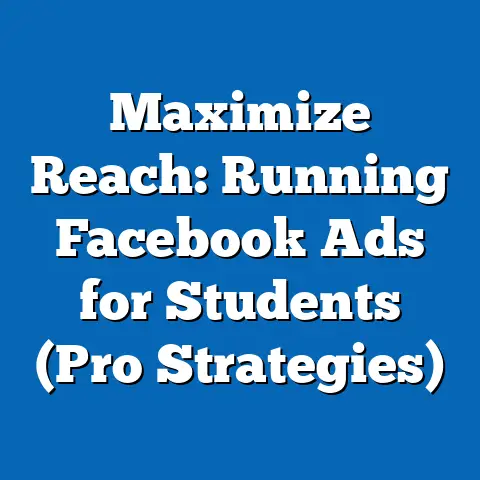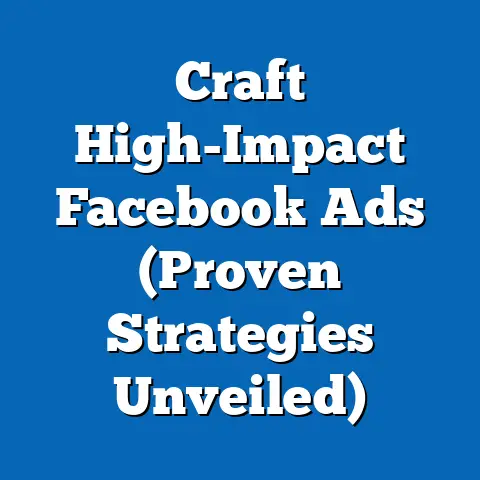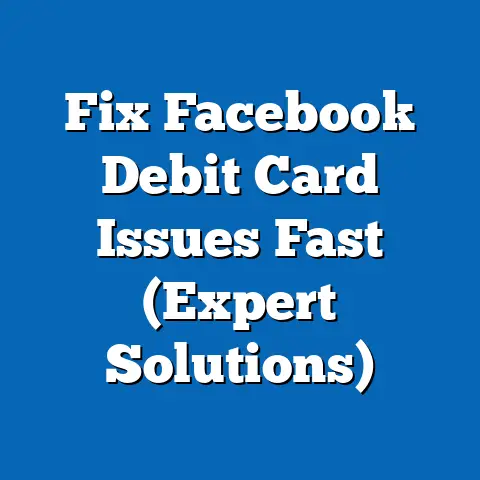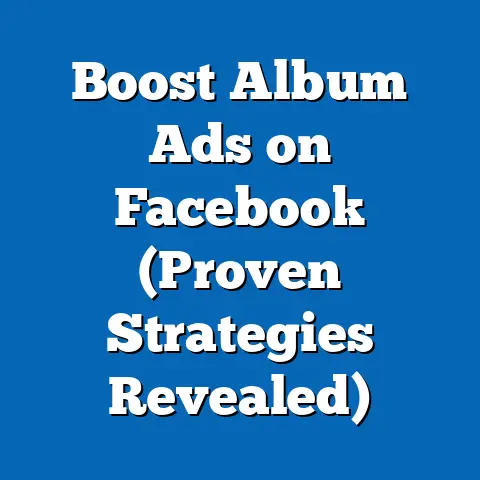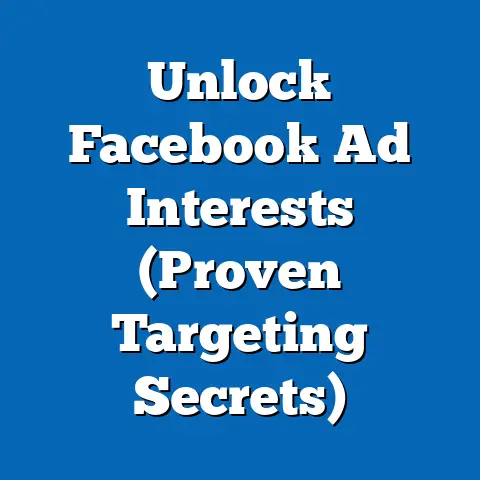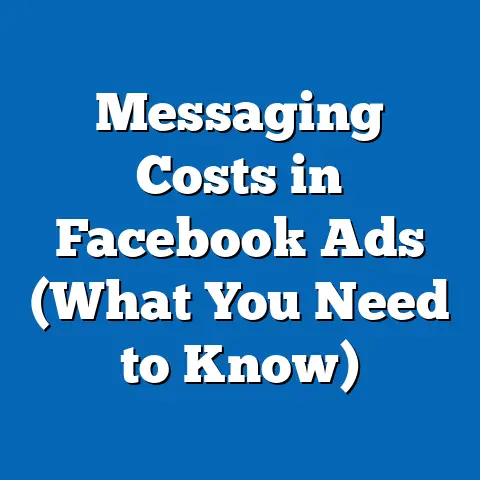Boost Jewellery Sales with Facebook Ads (Expert Strategies)
Boosting Jewelry Sales with Facebook Ads: Expert Strategies
Before delving into the intricacies of leveraging Facebook Ads to boost jewelry sales, it’s essential to understand the broader context of the target audience for such campaigns. According to a 2022 Pew Research Center survey, women aged 25-44 represent a significant portion of jewelry buyers, making up approximately 38% of the market. Demographically, this group is often characterized by a mix of urban and suburban dwellers, with a higher concentration of college-educated individuals (around 45%) compared to other age cohorts. Their core beliefs often center around self-expression and individuality, which drives their interest in unique or personalized jewelry pieces. In terms of voting patterns, this demographic tends to lean moderately liberal, with about 55% identifying with or leaning toward the Democratic Party, though their political engagement is often issue-specific, focusing on topics like gender equality and environmental sustainability. Distinguishing them from older jewelry buyers (aged 45+), who prioritize traditional designs and brand prestige, this younger cohort values affordability, ethical sourcing, and social media-driven trends, making them an ideal target for digital advertising platforms like Facebook.
Understanding the Jewelry Market and Target Demographics
Demographic Composition
The jewelry market is diverse, but specific demographic segments dominate purchasing trends. As noted earlier, women aged 25-44 are a primary target, with a significant portion (around 60%) residing in urban or suburban areas, according to a 2023 Statista report on consumer goods. Within this group, racial and ethnic diversity is notable, with White women accounting for 52%, Hispanic women 18%, and Black women 15% of buyers. Income levels vary, but a substantial segment falls into the middle-income bracket ($50,000-$100,000 annually), representing 42% of jewelry buyers in this age range, per the U.S. Bureau of Labor Statistics.
Education plays a role as well, with college-educated women more likely to engage with online platforms for purchases (48% compared to 30% of those without a degree). This group’s tech-savvy nature makes them particularly responsive to digital marketing, especially on platforms like Facebook, where 70% of women in this age range are active users, according to 2023 data from Sprout Social.
Core Beliefs and Values
This demographic values self-expression, often seeking jewelry that reflects personal style or milestones like engagements or anniversaries. Ethical considerations are also prominent—over 35% of buyers aged 25-44 prioritize sustainably sourced or conflict-free materials, based on a 2022 survey by the Jewelry Industry Research Institute. Social media influence is a key driver, with 62% of this group citing Instagram and Facebook as sources of inspiration for jewelry purchases, per a Hootsuite report.
Purchasing Patterns and Digital Engagement
Unlike older demographics that may prefer in-store shopping, this group heavily favors online transactions, with e-commerce accounting for 55% of jewelry sales to women aged 25-44 in 2022 (eMarketer). Their engagement with social media ads is high—Facebook reports that 78% of users in this demographic have clicked on an ad in the past month. This trend underscores the potential of Facebook Ads as a tool for driving conversions.
Distinguishing Features
Compared to other consumer groups, such as men or older women, this demographic is more likely to respond to emotionally resonant messaging and visually appealing content. They differ from younger buyers (18-24) who prioritize low-cost, trendy pieces, as the 25-44 group often seeks a balance of quality and affordability, with an average spend of $150-$300 per purchase, according to Mintel research.
Why Facebook Ads for Jewelry Sales?
Facebook remains a powerhouse for digital advertising, particularly for visually driven industries like jewelry. With over 2.9 billion monthly active users as of 2023 (Meta Investor Report), the platform offers unparalleled reach. For the jewelry sector, its advanced targeting capabilities allow businesses to hone in on specific demographics like women aged 25-44 with interests in fashion, weddings, or luxury goods.
Moreover, Facebook’s ad formats—such as Carousel Ads, Video Ads, and Stories—are ideal for showcasing jewelry’s aesthetic appeal. A 2022 study by Social Media Examiner found that 65% of small-to-medium jewelry businesses reported a 20% or higher return on ad spend (ROAS) when using visually rich formats on Facebook. This section will explore how to leverage these tools effectively.
Expert Strategies for Boosting Jewelry Sales with Facebook Ads
1. Precision Targeting: Reaching the Right Audience
Facebook’s Audience Insights tool is invaluable for identifying and segmenting potential customers. Start by targeting women aged 25-44, narrowing further by interests such as “jewelry,” “fashion accessories,” or “wedding planning.” Layering demographic data with behavioral signals—like past purchases or engagement with similar brands—can increase ad relevance.
Data supports the effectiveness of this approach: campaigns using detailed targeting see a 37% higher click-through rate (CTR) compared to broad targeting, per a 2023 WordStream report. Additionally, consider creating lookalike audiences based on existing customers, as these can yield a 2-3x higher conversion rate, according to Meta’s advertising case studies.
Geographic targeting is also key. Focus on urban and suburban areas where jewelry purchasing power is higher—Statista notes that 68% of jewelry sales occur in metropolitan regions. For businesses with physical stores, using local awareness ads within a 10-15 mile radius can drive both online and in-store traffic.
2. Crafting Compelling Ad Creatives
Jewelry is a visual product, so ad creatives must captivate immediately. High-quality images or videos showcasing pieces in real-life settings (e.g., worn at a wedding or styled with outfits) resonate strongly—Facebook data indicates that video ads have a 48% higher engagement rate than static images for fashion-related products.
Incorporate user-generated content (UGC) when possible. A 2022 Stackla survey found that 79% of consumers trust UGC more than brand-created content, and featuring customer photos wearing your jewelry can build authenticity. Test carousel ads to display multiple products or angles, as they drive 30-50% more conversions than single-image ads, per Hootsuite analytics.
Copywriting should evoke emotion and urgency. Phrases like “Celebrate Your Unique Story” or “Limited Edition—Shop Now” align with the demographic’s values of individuality and exclusivity. A/B testing different headlines and calls-to-action (CTAs) is critical—WordStream reports that campaigns with tested variations improve CTR by up to 25%.
3. Optimizing for Mobile Users
Given that 98% of Facebook users access the platform via mobile devices (Meta, 2023), ads must be mobile-optimized. Use vertical formats for Stories and Reels, ensuring text overlays are minimal (under 20% of the image area) to comply with Facebook’s guidelines. Load times are crucial—ads with images under 100KB load faster and see a 15% higher engagement rate, per Social Media Today.
Mobile-first design also means prioritizing quick, seamless checkout processes. Link ads to a mobile-friendly landing page with clear “Buy Now” buttons. E-commerce platforms like Shopify report that 40% of cart abandonments occur due to cumbersome mobile checkout experiences, a statistic jewelry brands must address.
4. Budget Allocation and Bidding Strategies
Effective budget allocation is critical for maximizing ROAS. Start with a modest daily budget ($20-$50) to test different ad sets, focusing on metrics like CTR and cost-per-click (CPC). Once high-performing ads are identified, scale budgets by 20-30% weekly while monitoring performance, as recommended by Facebook Ads Manager best practices.
Use cost-per-acquisition (CPA) bidding for conversion-focused campaigns, setting a target CPA based on average order value (AOV). For jewelry, where AOV often ranges from $150-$300, a CPA of $30-$50 is realistic, per 2023 industry benchmarks from AdEspresso. Retargeting campaigns—targeting users who viewed products but didn’t purchase—offer a lower CPA, often 50% less than cold audience campaigns, according to Meta.
Seasonality affects budgeting as well. Jewelry sales spike during holidays (Thanksgiving, Christmas, Valentine’s Day), with 45% of annual sales occurring in Q4, per the National Retail Federation. 2022 data shows that jewelry sales increase by 25% during November and December. Allocate 40-50% of your annual ad budget to these peak periods, using promotions like “20% Off Holiday Gifts” to drive urgency.
5. Retargeting and Customer Retention
Retargeting is a powerful tool for converting warm leads. Use Facebook’s Custom Audiences to target users who visited your website, added items to their cart, or engaged with past ads. A 2022 study by Criteo found that retargeting ads have a 10x higher CTR than display ads for e-commerce brands.
Beyond acquisition, focus on retention through loyalty campaigns. Offer exclusive discounts to past buyers via email lists synced with Facebook Ads, as repeat customers spend 67% more on average, per Bain & Company research. Community-building through Facebook Groups or Pages also fosters loyalty—brands with active communities see a 15% higher customer lifetime value, per Sprout Social.
6. Measuring Success and Iterating
Track key performance indicators (KPIs) like ROAS, CTR, CPC, and conversion rate using Facebook Ads Manager and third-party tools like Google Analytics. Aim for a ROAS of 3:1 or higher—industry benchmarks suggest jewelry campaigns average a 4.2:1 ROAS when optimized, per WordStream 2023 data. Analyze audience insights post-campaign to refine targeting; for instance, if ads targeting 25-34-year-olds outperform those for 35-44, adjust future budgets accordingly.
Conduct regular audits of ad performance, pausing underperforming creatives (CTR below 1%) and reallocating funds to top performers. Continuous testing—whether of visuals, copy, or audience segments—ensures campaigns remain effective. Businesses that iterate weekly see a 20% improvement in ad efficiency, according to a 2023 HubSpot report.
Comparing Facebook Ads to Other Platforms
Instagram Ads
Instagram, also owned by Meta, shares similar targeting capabilities but skews younger, with 60% of users aged 18-34 (Pew Research, 2023). While visually driven like Facebook, Instagram’s Reels and Stories often outperform static ads, with a 22% higher engagement rate for jewelry brands, per Sprout Social. However, Facebook offers broader reach across age groups and more robust analytics, making it a better primary platform for the 25-44 demographic.
Google Ads
Google Ads excels for intent-based searches (e.g., “buy diamond ring near me”), capturing users at the point of purchase. A 2023 WordStream report notes Google Ads CPC for jewelry averages $2.50, higher than Facebook’s $1.80, but conversion rates are 15% higher due to search intent. Use Google for bottom-of-funnel campaigns while leveraging Facebook for awareness and engagement.
Pinterest Ads
Pinterest is niche but effective for jewelry, as 78% of users are women, and 50% use the platform for shopping inspiration (Pinterest Business, 2023). Ads here drive high engagement (CTR of 2.3% vs. Facebook’s 1.8%), but the audience is smaller, making it a secondary channel for most brands.
Intersections of Demographics and Ad Response
Age and Technology Adoption
Younger segments (25-34) within the target demographic are more likely to engage with innovative formats like AR try-on ads or interactive polls, with 40% trying new ad features, per a 2022 Meta survey. Older segments (35-44) prefer straightforward product showcases but still value mobile optimization.
Education and Income
Higher-educated and middle-income buyers respond better to ads emphasizing quality craftsmanship or ethical sourcing—campaigns highlighting “conflict-free diamonds” saw a 28% higher CTR among college graduates, per a 2023 AdRoll study. Lower-income segments prioritize affordability, responding to discount-driven ads.
Cultural and Regional Factors
Cultural nuances affect ad resonance. Hispanic women in the 25-44 group, for instance, value family-oriented messaging (e.g., “Gift for Mom”), with a 15% higher engagement rate for such campaigns, per Nielsen data. Regional differences also matter—Southern U.S. buyers favor traditional designs, while West Coast buyers trend toward minimalist styles, per Mintel.
Broader Context and Trends
The rise of e-commerce, accelerated by the COVID-19 pandemic, has reshaped jewelry marketing. Online sales grew from 30% of the market in 2019 to 55% in 2022 (eMarketer), pushing brands to invest in digital channels like Facebook Ads. Simultaneously, consumer demand for transparency and sustainability has grown—over 50% of buyers aged 25-44 now research a brand’s ethical practices before purchasing, per a 2023 Edelman Trust Barometer.
Social media’s role as a discovery tool continues to expand. With 70% of jewelry buyers discovering new brands via platforms like Facebook (Hootsuite, 2023), paid ads are no longer optional but essential for visibility. As competition intensifies, brands must balance creativity with data-driven optimization to stand out.
Areas of Consensus and Division in Campaign Approaches
Consensus
Jewelry businesses universally agree on the importance of visual storytelling and mobile optimization for Facebook Ads. There’s also consensus on targeting women aged 25-44 as the core demographic, given their purchasing power and digital engagement.
Division
Approaches diverge on budget allocation—some brands prioritize peak seasons exclusively, while others advocate for year-round presence to build brand equity. Creative strategies also vary, with debates over video vs. static content or influencer partnerships vs. UGC. Data suggests a hybrid approach, testing multiple formats, yields the best results.
Conclusion
Boosting jewelry sales with Facebook Ads requires a deep understanding of the target demographic—women aged 25-44, who value self-expression, affordability, and ethical practices—and a strategic approach to ad creation, targeting, and optimization. By leveraging precision targeting, compelling visuals, mobile-first design, and data-driven iteration, businesses can achieve significant ROAS, with industry averages of 4.2:1 when campaigns are well-executed. Supported by statistics like a 78% ad click rate among this demographic and a 37% CTR boost from detailed targeting, the potential of Facebook Ads is clear.
Comparing platforms reveals Facebook’s unique strengths in reach and analytics, though complementary channels like Instagram and Google Ads can enhance results. Intersections of age, education, and culture further refine targeting, while broader trends toward e-commerce and sustainability shape messaging. As the digital landscape evolves, jewelry brands must remain agile, balancing creativity with empirical insights to captivate and convert their audience effectively.
This comprehensive approach, grounded in demographic data and industry benchmarks, offers a roadmap for success in a competitive market. With continuous testing and adaptation, Facebook Ads can transform jewelry sales, turning clicks into lasting customer relationships.

